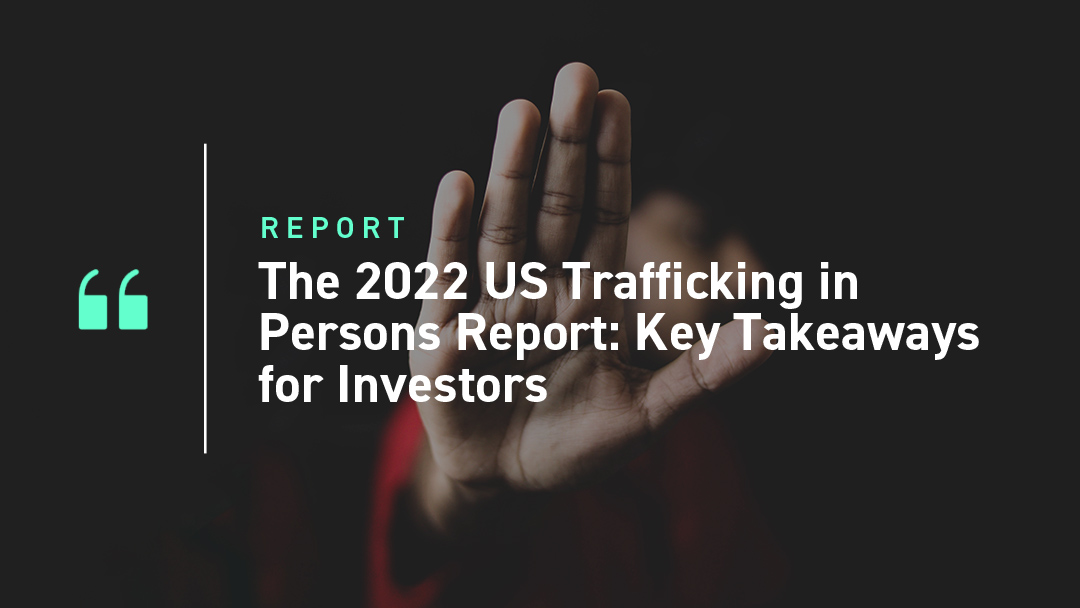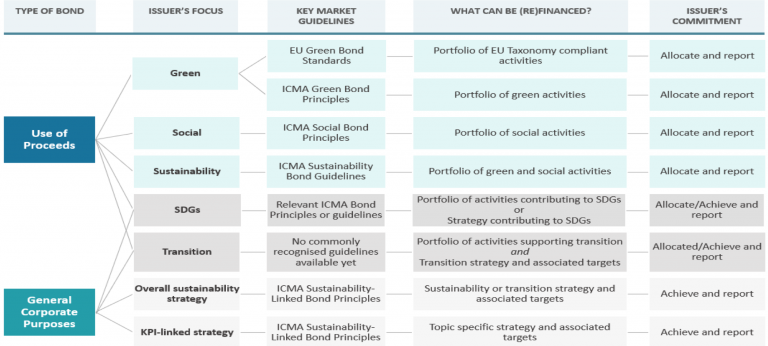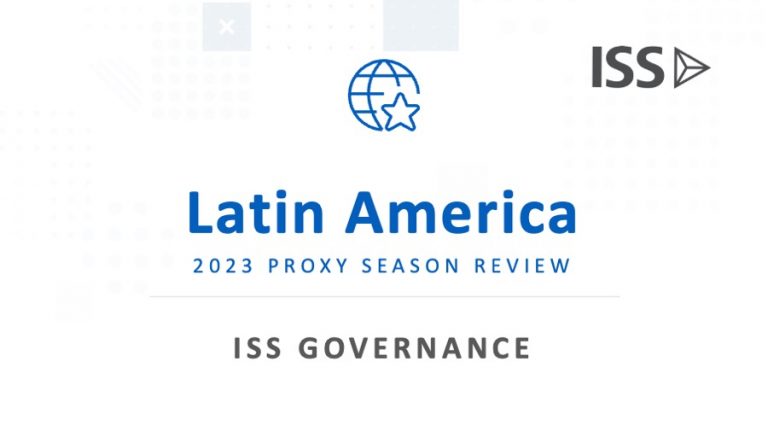The World Day Against Trafficking in Persons theme this year is the role of technology in both enabling trafficking, through the recruitment, exploitation, and control of victims online; and disrupting trafficking, through awareness raising and innovative solutions to identify exploitation.
One week ahead of the World Day Against Trafficking in Persons, the United States released its annual Trafficking in Persons (TIP) report. The TIP report is the government’s principal diplomatic and diagnostic tool to guide relations with foreign governments on human trafficking, providing a country-by-country assessment of anti-trafficking efforts. The report highlighted the important role of technology in collecting, analysing, and disseminating data on the prevalence of trafficking and the effectiveness of anti-trafficking policies.
ISS ESG has recently released a comprehensive dataset on human trafficking and the broader range of exploitative practices that fall under the modern slavery umbrella. The Modern Slavery Scorecard, covering approximately 7,400 companies, helps investors assess their portfolio exposure to modern slavery by providing granular data on location, industry, and product risk; and by identifying gaps in risk mitigation.
What is Trafficking in Persons?
The TIP report defines “trafficking in persons,” a term interchangeable with “human trafficking,” by using a three-part framework – acts, means, and purpose – based on the United Nations Protocol to Prevent, Suppress and Punish Trafficking in Persons. Human trafficking refers to situations where a person is recruited, harboured, transported, provided, or obtained for labour or commercial sexual services (acts), by force, fraud, or coercion (means) in order to exploit them (purpose). The US recognises two forms of trafficking: forced labour and sex trafficking. Both forms fall under the umbrella term, modern slavery.
Human Trafficking in the Midst of a Refugee Crisis
Released in the context of an ongoing global pandemic; and mass migration driven by a climate crisis and global conflict; the TIP report findings present what US Secretary of State Antony J. Blinken described as a “mixed picture of progress.”
The TIP report uses a four-tier system that reflects a government’s efforts to meet minimum standards in eliminating trafficking, rather than the scale of trafficking in a country. In recognition of their significant efforts to address trafficking, 21 countries were upgraded a tier in the most recent report. Vietnam, Indonesia, Bulgaria, and Belarus are among 18 countries downgraded a tier, reflecting a perceived lack of progress in preventing or prosecuting trafficking or providing protection for survivors.
For the first time, the TIP report has included a section on State-Sponsored Trafficking in Persons, making explicit the involvement of governments in trafficking crimes. The report has determined that 11 countries show a “government policy or pattern” of human trafficking.
Russia’s invasion of Ukraine has created significant risks of exploitation for the millions of refugees fleeing Ukraine. The majority (90%) are women and children, who are disproportionately more vulnerable to modern slavery. The International Organization for Migration and Europol have received early reports of possible traffickers targeting refugees, under the pretext of offering transport or accommodation services, in countries bordering Ukraine.
ISS ESG’s Modern Slavery Scorecard indicates that several of the countries bordering Ukraine are considered at risk for modern slavery. The assessment considers a country’s vulnerability to modern slavery based on key risk indicators including: basic labour rights and working conditions; inequality; political stability; corruption; safeguarding of civil and political rights; discrimination; and gender equality.
Figure 1: Vulnerability to Modern Slavery in Ukraine and Neighboring Countries (Red: High vulnerability to modern slavery; Amber: Moderate vulnerability to modern slavery)
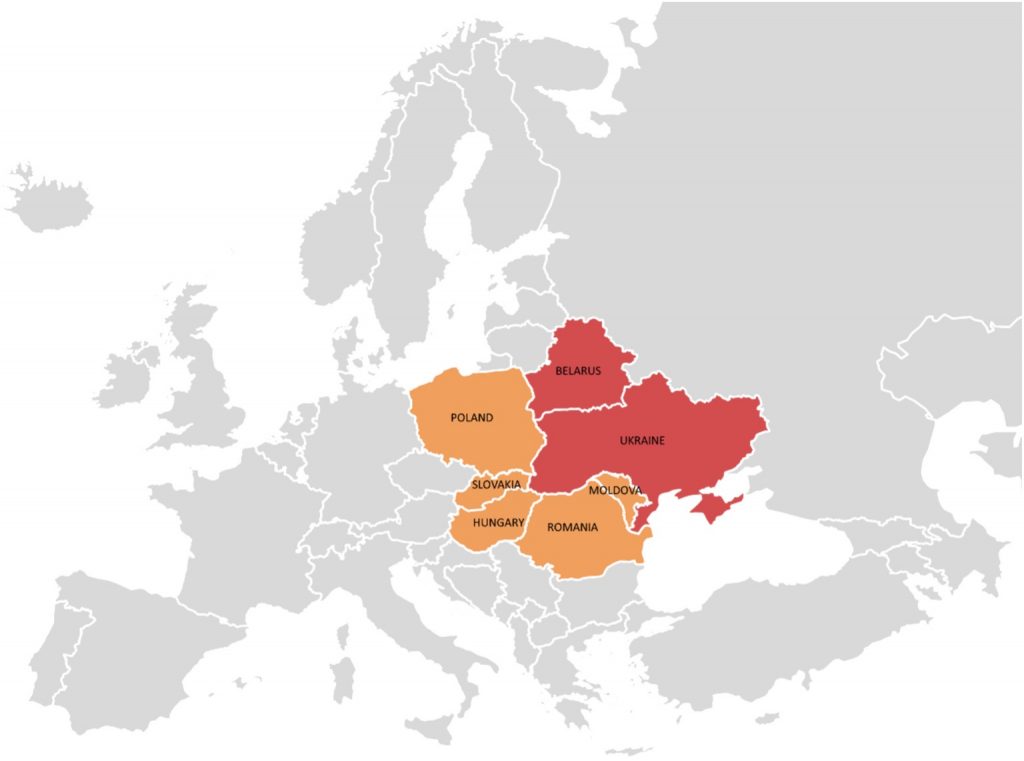
Source: ISS ESG Modern Slavery Scorecard
Previous conflict situations suggest refugees are particularly vulnerable to exploitation in labour-intensive, base-skill sectors such as hospitality and agriculture in arrival countries. Economic hardship and challenges accessing their bank accounts in the conflict-affected country can lead refugees to take jobs they may not have otherwise accepted. The financial sector can help refugees establish themselves in new countries and avoid debt-based coercion through access to basic banking services and stable lines of credit.
Increasing Human Rights Concerns as the Demand for Clean Energy Technologies Grows
In the push to Net Zero, investors, businesses, and governments are increasingly facing pressure to meet two goals:
- Moving away from fossil fuels and towards clean energy alternatives; at the same time as
- Ensuring the transition does not have a human cost.
This year’s TIP report highlights the trafficking risks in clean energy supply chains, particularly those associated with cobalt for electric vehicles and polysilicon for solar panels.
China’s Xinjiang Uyghur Autonomous Region, reportedly the location of state-sponsored forced labour of Uyghur and other ethnic minorities, dominates the solar energy supply chain. Approximately 40% of global polysilicon supply originates from Xinjiang, with a further 30% sourced from other regions in China, which may also be linked to Uyghur labour. The TIP report also points to reports of poverty-driven child labour in cobalt mining in the Democratic Republic of the Congo.
The ISS ESG Modern Slavery Scorecard evaluates a company’s mechanisms for identifying risk, carrying out due diligence, and implementing corrective action in the company’s supply chain. ISS ESG’s assessment indicates that more than half (53%) of utilities companies, including those that engage in the generation and distribution of renewable electricity, are poorly prepared to address forced labour risks. Similar performance is seen for companies that are linked to cobalt through their auto components, semiconductor, and electronic supply chains.
Figure 2: Performance in Responding to Forced Labour Risks, by Industry Group
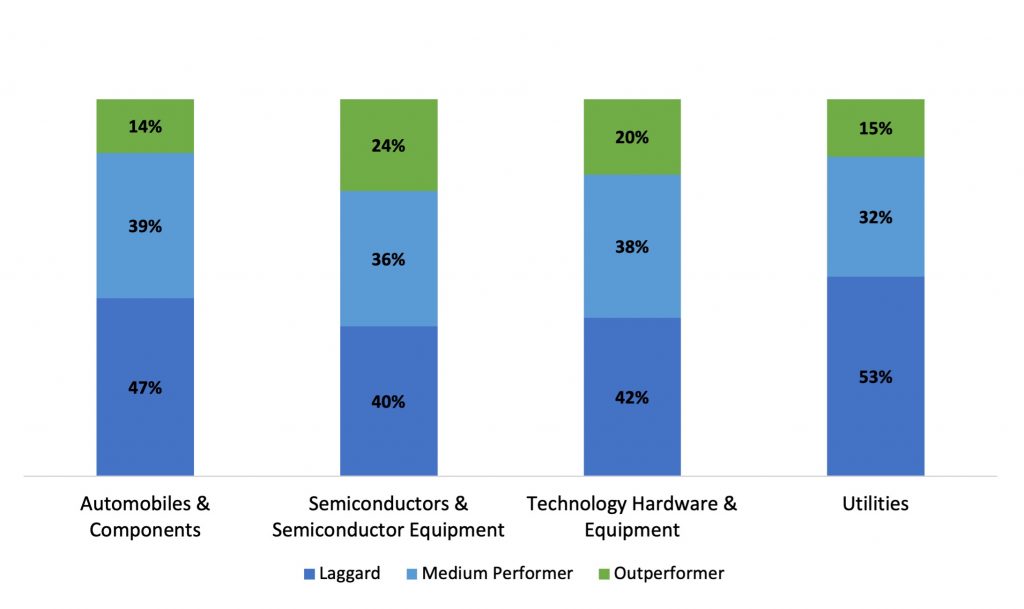
Source: ISS ESG Modern Slavery Scorecard, Modern Slavery Disclosure & Performance Category for a sample of industry groups
The TIP report sees the urgent climate crisis as an opportunity to make clean energy supply chains more responsible, transparent, and traceable, through high ESG standards and science and technology innovations. The report points to several resources that provide guidance on responsible business conduct for critical mineral supply chains.
The Inclusion of Survivors, on Their Own Terms, Is Crucial to the Effectiveness of Anti-slavery Practices, Policies, and Strategies
The TIP report calls strongly for better engagement of survivors in anti-trafficking efforts, “to support, normalize, and secure the meaningful and ongoing inclusion of survivors as leaders, experts, and equal partners in decision-making processes.”
The report provides examples of governments engaging survivors in program and policy development, including through advisory councils, training, and technical assistance mechanisms. The report also encourages the private sector to include survivor engagement and expertise in the development of company policies, codes of conduct, and strategic planning. For investors, this could include the following:
- Hiring survivors as employees or advisors to provide modern slavery and human trafficking awareness and identification training or to inform engagement with investee companies on matters such as best practices in remediating a modern slavery incident.
- Drawing on survivors’ expertise to identify modern slavery and human trafficking in financial transactions. The TIP report highlights that survivor leaders can advise financial institutions on how trafficking may present itself on bank records and credit card transactions of individuals experiencing exploitation.
- Informing decision-making with research that is led by survivors or incorporates survivors’ expertise. For example, the Modern Slavery & Human Rights Policy & Evidence Centre requires its research applications to clearly set out survivor involvement. The Centre also plans to establish a Lived Experience Advisory Panel this year.
The TIP report provides guidance on meaningful survivor engagement and mitigating tokenism, including clearly defining the scope and purpose of the engagement, providing competitive compensation, and building organizational capacity in trauma-informed approaches. The TIP report’s guidance, along with the assessments of the ISS ESG Modern Slavery Scorecard, may provide investors with the tools they need to help identify potential investment in human trafficking, and manage the associated risks.
Explore ISS ESG solutions mentioned in this report:
- Identify, evaluate and act on modern slavery risks and their impact on investments with the Modern Slavery Scorecard.
- Access to global data on country-level ESG performance is a key element both in the management of fixed income portfolios and in understanding risks for equity investors with exposure to emerging markets. Extend your ESG intelligence using the ISS ESG Country Rating and ISS ESG Country Controversy Assessments.
By: Clare Bartram, ESG Specialist, Modern Slavery
